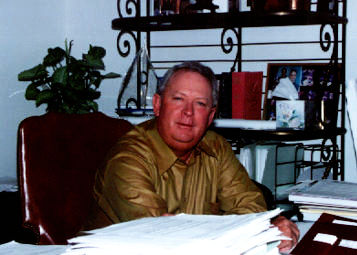Callahan Property Celebrates 20 Years of Hacienda
Callahan Property Celebrates 20 Years of Hacienda

Chamber Salutes Developer's Efforts in Creating Park
In 1978, the I-680 freeway had been open for just eight years, the I-580 Dublin Grade had yet to be finished, and Joe Callahan of Callahan Property Company purchased the first of six parcels that would become Hacienda. The twentieth anniversary of Callahan's visionary purchase was celebrated recently by the Pleasanton Chamber of Commerce.
A graduate of the Naval Academy and a Vietnam veteran, Callahan already had a hand in the development of several Bay Area properties, including projects like Moffett Park in Sunnyvale and the Oak Creek Business Park in Milpitas. Working with him on several of these projects was the Prudential Insurance Company of America, his partner in developing Hacienda.
"The genesis of the start of Hacienda was some three years earlier, when an associate of mine and I attempted to put Fairchild Semiconductor in a then- vacant Volkswagen Distribution Center, where the Hilton and Club Sport currently are," explains Callahan. "We weren't able to do that, but the fact that I-580 and I-680 were here caught my attention."
Callahan's research showed great potential in Pleasanton. Zip code analysis revealed that between 40 and 50 percent of employed residents in the Tri-Valley area worked in Santa Clara County.
"Combine that with the fact that you could drive from downtown San Jose to 580/680 in 18 minutes, and from 92 and 101 in those days, believe it or not, in under a half hour, and from the Financial District in San Francisco to 580/680 in 40, 45 minutes, and it became obvious that there was an opportunity to create an employment center," he says. "What drove Hacienda was the relationship of the 580/680 interchange to the major employment centers in the region."
Infrastructure and Flood Control
By 1982, Callahan and Prudential had purchased most of the underlying land of the current park and in July of that year recorded their map for subdividing the first 600 acres. Although the subdivision map was approved, development was slowed at that time by a successful lawsuit against the City of Pleasanton, challenging the General Plan on the basis of the high ratio of commercial and industrial zoned land to residential.
The community's efforts to re-create the General Plan got underway immediately. A revision to the General Plan would require a new environmental impact report (EIR) for Hacienda, but since the subdivision map had been accepted, Callahan and Prudential decided to begin infrastructure improvements that would support the park's development.
A Speculative Venture
Development started with reconstruction of various roads, including Hopyard and Stoneridge. "We also went out by Bernal Avenue and I-680 and opened up the Arroyo de la Laguna in that area, and by doing that we dropped the flood plain for the entire city by about 4.5 feet."
Callahan and Prudential also elected to go forward with a number of buildings, despite the fact that they had no guarantee that tenants would be interested in the property.
"We did that because there were two or three major lease transactions in the Bay Area market and we concluded that if we had the product we had a good chance at making the deals," he said.
Their evaluation was correct. By 1985, 1.3 million square feet had been built and about 1 million feet of that had been leased, including 400,000 square feet to AT&T for its regional headquarters, which moved out of San Francisco.
Also in 1985, the General Plan revision was completed and a new EIR for Hacienda was certified. However, many Pleasanton citizens were unsure at the new direction for the city as described in the plan, so signatures were collected calling for a referendum on the plan.
"We won at the polls, 65 percent to 35 percent, with a huge voter turnout," says Callahan. He believes the infrastructure improvements played a key role in proving their intentions to the community. The citizens' support was solid.
A Vision Achieved
With demonstrated community support, development began in earnest. Improvements to freeway interchanges began in 1985 and plans for the current BART station were established in 1986. Negotiations for the 1.1 million square foot AT&T Center were concluded in 1987. A total of 4.5 million square feet of improvements were in place by the end of 1988. Over 7.5 million square feet exist today.
Callahan left day-to-day management of Hacienda in 1989, but still maintains an active interest in the park. With Hacienda approximately 65 to 70 percent built out, Callahan is proud of how things have turned out. "I'm pleased to see that the things I expected to happen are happening," he says. "The project is succeeding in both attracting the kind of major corporations I always expected it to attract and it's getting the kind of values for the infrastructure that are warranted by our investment."
Photo: Joe Callahan purchased the first of the six parcels that became Hacienda in 1978. The first tenants arrived in 1983.
Also in this issue...
- Roche to Expand in Park After Acquisition
- Callahan Property Celebrates 20 Years of Hacienda
- Business Bits
- Executive Profile: Tom Sinton of ProBusiness
- Extended Stay Specialists Sierra Suites Adds an Additional Option to Hacienda's Hotel Menu
- Researchers Seek Participants for First U.S. "Smart Car Linking" Study
- Borders Books Offering Corporate Discounts, New Lunchtime Workshops
- Guaranteed Ride Home Program to Benefit Park Commuters
- Hacienda Index




